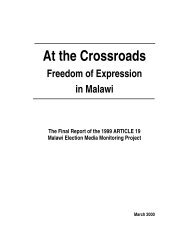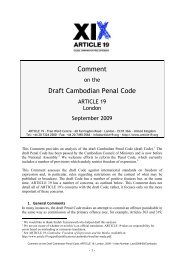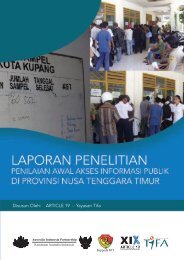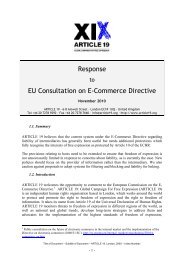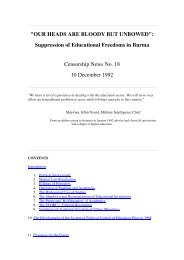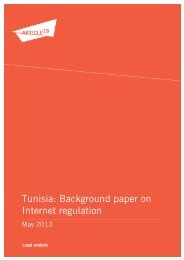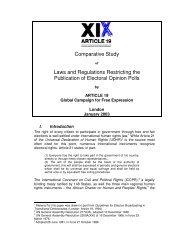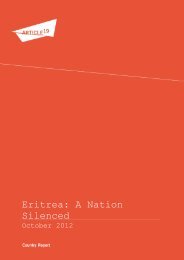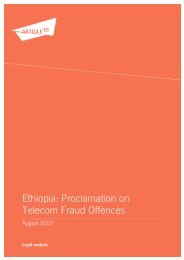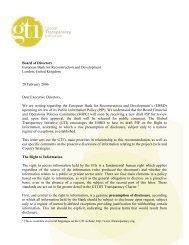FOR INTERNAL USE ONLY - Article 19
FOR INTERNAL USE ONLY - Article 19
FOR INTERNAL USE ONLY - Article 19
- No tags were found...
Create successful ePaper yourself
Turn your PDF publications into a flip-book with our unique Google optimized e-Paper software.
ARTICLE <strong>19</strong>GLOBAL CAMPAIGN <strong>FOR</strong> FREE EXPRESSIONrefuse heaps occupy 164,000 hectares, nearly 4% of the territory. Non-industrial waste in urban areaslies in 700 disposal sites; at 80% of their locations no measures are taken to prevent pollution ofunderground waters or the air. 48Stockpiles of obsolete pesticides do not meet safety standards and pollute soil and subsoilwaters, as a result of which people have been poisoned. Such pesticides are frequently used inunauthorised ways, and many of them are mixtures of unidentified substances. In addition to officiallyacknowledged stockpiles, environmental experts believe that there are unaccounted stockpiles ofpesticides throughout Ukraine which continue to deteriorate and for which no one is held responsible.These substances are not kept in safe containers, but only in thick paper and plastic bags. 49 Afew stakeholders know about it, but the general public tends to be unaware. Despite this, thestockpiling of dangerous substances continues, especially in rural areas, where there is inadequateoversight by the administrative district centres. 50Another threat to the environment is posed by nuclear energy and radioactive waste storagesites. 51 According to the Nuclear Threat Initiative, there are six spent nuclear fuel storage sites andmany low-level radioactive waste storage sites in Ukraine. 52 It has been reported that many of themilitary’s storage sites are inadequately built and require urgent repair. 53Information about nuclear issues is hard to come by. The desire to preserve nuclear energy asan energy source in Ukraine, accompanied by the importance given to atomic energy worldwide,effectively curtails open debate in this area. At the same time, the Ukrainian government has nodetailed, accurate data about levels of nuclear pollution across the country. Since <strong>19</strong>91 theinfrastructure and means to measure radioactivity have continuously deteriorated, leaving doubts as totheir accuracy. The lack of reliable government information on the hazards of radioactivity encouragesrumours. 54Ukraine still depends on nuclear energy: four nuclear power stations produce nearly half of thecountry’s electricity. The government plans to double nuclear energy output by 2030. Among the48 Information from EcoPravo-Kyiv.49 Interview with Tetyana Tymochko – First Vice-Chairman of the All-Ukrainian Ecological League and Head ofthe Aarhus Information and Training Centre.50 Ibid.51 See Section 2.1 below.52 The Nuclear Threat Initiative, ‘Ukraine: Spent Fuel and Radioactive Waste Developments’, 28 October 2004.http://www.nti.org/db/nisprofs/ukraine/reactors/power/wastedev.htm.53 OSCE, Our Polluted World and Cleaning it Up, quoted in ‘Ukraine, Belarus and Moldova Choking on ToxicWaste’, Terradaily, 23 May 2007.54 Interview with Volodymyr Usachenko, Government Commission on Chornobyl and former ‘liquidator’, April2007.For Internal Use Only. Is Post-Chornobyl Ukraine Ready for Access to Environmental Information?ARTICLE <strong>19</strong>, London, 2007+(



